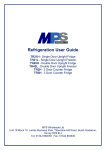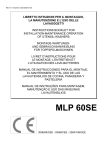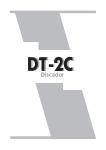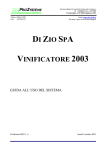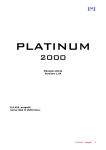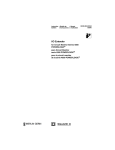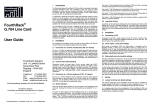Download Mach MS 900E Technical data
Transcript
REV.00 15/07/05 COD.6000276.00 INSTRUCTIONS BOOKLET FOR INSTALLATION-MAINTENANCE OPERATION FOR DISH-WASHERS MS 900E 73/23 - 93/68 - 89/336 Always switch off the appliance at the end of the work cycle, turn off the water and disconnect the power supply. INTRODUCTION 1) Read the instructions in this booklet carefully as they provide important information, use and maintenance. Keep the booklet to hand in a safe place so that it can be consulted by other operators. 2) After removing the packing material, check that all the equipment is present and intact. If there is any doubt, do not use it and contact qualified personnel. The packing elements (plastic bags, foam polystyrene, nails, etc.) should be kept away from children, because they are dangerous. 3) Before switching the equipment on, make sure that the model plate data conforms to that of the electrical and water distribution network. 4) Installation should be carried out by qualified personnel according to the manufacturer’s instructions. 5) This equipment must be destined to the use which it has been conceived for. Any other application should be considered improper and consequently dangerous. 6) The equipment should be used by personnel trained for its use only. 7) Do not leave the machine in an environment at temperatures lower than 0°C. 8) The protection of the machine is IPX4, therefore it should not be washed with high pressure and directed water jets. 9) Qualified personnel only can access the control panel, after having disconnected the machine from the primary current supply. 2 1. TECHNICAL DATA 4 1.1 SCHEMATIC VIEW 5 1.2 ELECTRICAL DIAGRAM 6 2. INSTALLATION 8 2.1 CONNECTION TO POWER SUPPLY 8 2.1.1 GROUND 8 2.2 CONNECTION TO WATER SUPPLY 9 2.3 WATER DRAIN 10 3. INSTRUCTIONS FOR USE 12 3.1 START UP 12 3.1.1 WASHING PROGRAMMES 14 3.1.2 DETERGENT AND RINSE AID 14 3.2 CLEANING 15 3.3 IF THE DISHWASHER IS NOT USED FOR LONG PERIODS 16 4. IN CASE OF MALFUNCTIONS 16 5. SERVICEABILITY 16 3 1. TECHNICAL DATA • The specifications tag (Fig. 1-1) is placed on the right-hand panel of the machine. It contains all the neccessary data to install the appliance. Fig. 1-1 MS 900E • Overall dimensions mm 650 x 710 x 1460 • Basket size mm 500 x 500 • Washing power P/h 900 • Tank capacity lt 34 • Boiler capacity lt 11 n x mm2 3x4 • Power cable 4 1.1 SCHEMATIC VIEW Fig. 1-2 A • Water drain ∅ 30 • Connection to water mains B 5 3/4’ G 1.2 ELECTRICAL DIAGRAM 6 Rif. Description C1 Suppression filter CB Boiler contactor CL Power supply contactor CR-CR1 Relays contactor CR2 (optional) Relays contactor CV Tank contactor DB (optional) Electric additive distributor DD (optional) Electric detergent distributor EB Boiler solenoid valve IG Main switch M Terminal board MP Door microswitch PL Washing pump PS (optional) Drainage pump PV Tank pressureswitch R-R1 Relays R2 (optional) Relays RB Boiler heating element RV Tank heating element SB Boiler pilot lamp SC Start pilot lamp SCV Cycle selector SL Power pilot lamp ST Start SV Tank pilot lamp T Timer T1 Timer ciclo1 T2 Timer ciclo2 TB Boiler thermostat TPL Washing pump contactor TSB Boiler safety Thermostat TV Tank thermostat 7 2. INSTALLATION • Installation, initial start-up and maintenance of the appliance must be carried out by qualified personnel only. All hydraulic and electrical connections must be carried out in compliance with current safety norms. The manufacturer accepts no responsibility for malfunctions arising from incorrect connection of the appliance. When installing, ensure that the appliance is perfectly level. Turn the adjustable feet clockwise or anticlockwise to level the appliance. The following norms must be observed when installing the appliance: 1. current accident -prevention regulations 2. CE standards 3. water board regulations 2.1 CONNECTION TO POWER SUPPLY • The electrical panel is located on the front of the appliance. The connection to power supply is on the back side of the appliance. The power cable (G) must have a rating of at least H05VVF, and each wire must have a section of 2.5 mm². N.B. : In accordance with international standards, a cut-out switch (A), provided with amperage-adequate fuses (see technical specification), must be installed between the mains electricity supply and appliance. The contacts must have an aperture of at least 3 mm.The main switch (A) should be positioned in the immediate vicinity of the appliance and should be easily accessible. Fig. 2-1 2.1.1 GROUND • The appliance must be grounded. The ground terminal screw is located on the rear panel of the appliance, and marked by the symbol . N.B. : The manufacturer accepts no responsibility or warranty obligations in case of damage arising from non-compliance with this requirement or from incorrect installation. 8 2.2 CONNECTION TO WATER SUPPLY • The appliance is designed for connection to the cold or hot water supply (max. 50 55°C) at a mains pressure with the valve open as shown in Table 2-1 and a minimum output of 10 litres/min. If pressure exceeds the maximum, fit a pressure reducer. If pressure is lower than the minimum, fit a pressure booster pump of max. 0.5 HP, with an output of 20 litres/min. and a head of 15÷20 metres. Pressure must be measured at the solenoid valve inlet (see fig. 2-4). The water pipes must have an internal diameter of at least 16/18 mm (see fig. 2-5). Connect the appliance water supply pipe to a cut-out tap (B), preferably placed close to the appliance, fitting the special filter provided (B1) (see fig. 2-2). We recommend fitting a water softener (C) (not provided) upstream from the machine solenoid valve (see fig.2-3). Tab. 2-1 Temperature Pressure max 50-55 °C 1.5 - 3 bar Fig. 2-2 Fig. 2-3 INLET WATER PRESSURE 1.5 - 2 bar 2 - 2.5 bar 2.5 - 3 bar minimum good very good 9 Fig. 2-4 WATER/CYCLE DRAIN FOR MAINS RINSE 2.5 litri 2.5 - 3 litri 2.5 - 3 litri 3 - 4 litri minimum very good for glass-washers good for dish-washers very good for dish-washers Fig. 2-5 2.3 WATER DRAIN • Connect the drain hose of the appliance to the outlet (D), fitting a siphon between the hose and the outlet. Alternatively, place the appliance over a drainage well (E), which should be fitted with a cover (F) to prevent the build-up of unpleasant odours. 10 Fig. 2-6 Fig. 2-7 11 Fig. 2-8 3. INSTRUCTIONS FOR USE • The appliance is designed to wash crockery. Use a suitable low-foam detergent. Plates and dishes should be scraped clean of residue, which might clog the drain and nozzles. Fill the basket carefully. N.B. : It is advisable to remove large food remains. The best results are obtained when the items are washed after pre-washing or soaking. 3.1 START UP • Turn on the water tap (B) and switch on the master switch (A). Turn the appliance ON switch (1), which will cause the warning light (A) to illuminate, indicating that the machine is live. When the door is closed the appliance fills with water. When it is full, the tub and boiler heating elements come on automatically. When the elements are activated, the warning lights (C) and (B) are illuminated. When both warning lights go out the water has reached the set temperature and the appliance is ready to begin the washing cycle. (Fig. 3-1 - 3-2) N.B. : The set temperatures are the ones recommended by the manufacturer, however the thermostats allow to adjust the temperature at max 90°C 12 RECOMMENDED TEMPERATURE boiler 90°C tub 60°C Fig. 3-1 Fig. 3-2 13 3.1.1 WASHING PROGRAMMES • When the water intake cycle is complete, open the door (I) and add detergent (about 2 g. per litre of tank capacity). Position the full basket (L) and close the door (I). Select the appropriate washing cycle by pressing button (3) (short cycle I button pressed, long cycle II button not pressed. Now press the START button (4) and the wash cycle displayed by light (D) will start. When the cycle is over, this light goes out. To turn off the appliance, turn the switch (1) to 0. Light (A) indicates the appliance is off (Fig. 3-1 ÷ 3-3). Add detergent every 5 - 6 wash cycles. N.B. : It is recommended ta start the wash cycle when both litgh of the heating elements, boiler (C) and tank (B) are off, as indicated at point 3.1 Start up. Fig. 3-3 3.1.2 DETERGENT AND RINSE AID • The detergent dispenser (M) rinse aid dispenser (N) are regulated by the manufacturer. If the setting needs to be changed, turn the regulating screw on the dispensers. The detergent and rinse aid containers (if not provided with the appliance) should be placed next to the machine and connected to the transparent pipes fitted to the back of the appliance (Tank for the detergent and Boiler for the rinse aid). Fig. 3-4 14 3.2 CLEANING • Cleaning is extremely important for proper operation of the appliance. We recommend cleaning at the end of each work cycle. Turn off the 0-I switch, wash all the removable parts in running water and replace them with care. WARNING : Before removing the filters (S) clean residual foreign matter from the bottom of the tub. N.B. : Turn off the master switch (A) before cleaning the outer coating, without using direct or high pressure water jets. Wash all parts of the appliance with neutral detergents (not corrosive or aggressive). Fig. 3-5 Fig. 3-6 15 3.3 IF THE DISHWASHER IS NOT USED FOR LONG PERIODS • If the machine is not used for a long period, clean it carefully. Wash and dry the tub and the filters. Leave the door open while the machine is not in use. Turn off the water and disconnect the power supply. 4. IN CASE OF MALFUNCTIONS • In case of malfunctions, immediately switch off the appliance, turn off the water and disconnect the power supply. Call a service technician. 5. SERVICEABILITY IMPORTANT QUALIFIED PERSONNEL ONLY • The electrical control panel features all the appliance’s components except : pump, heating elements, rinse-aid dispenser and solenoid valves. These components can be accessed by removing the lower front panel. N.B. : Before any technical service, disconnect the machine from the mains. (Fig. 5-1) Fig. 5-1 16 17 18 19 Unit 7, Church Park, Lowfield Heath, Crawley, West Sussex RH11 0PW Sales: 01293 571199 ▪ Fax: 01293 571133 Email: [email protected] ▪ www.mpswholesale.co.uk 20






















